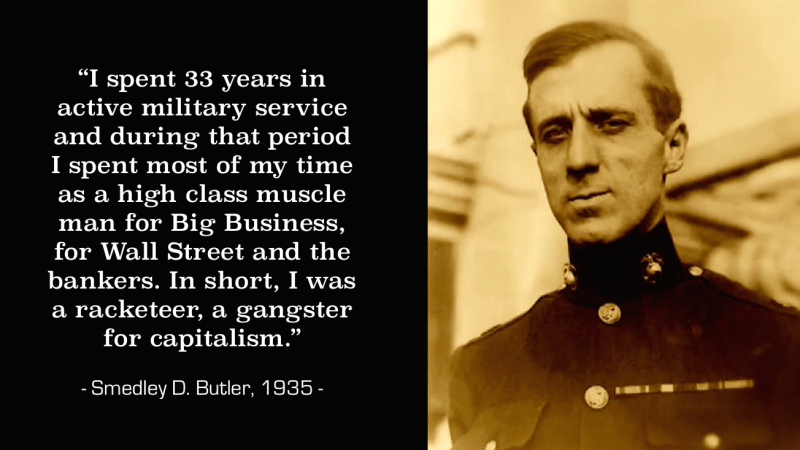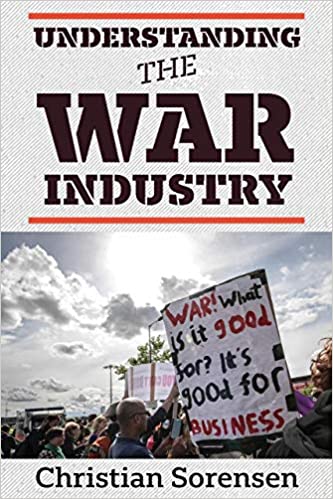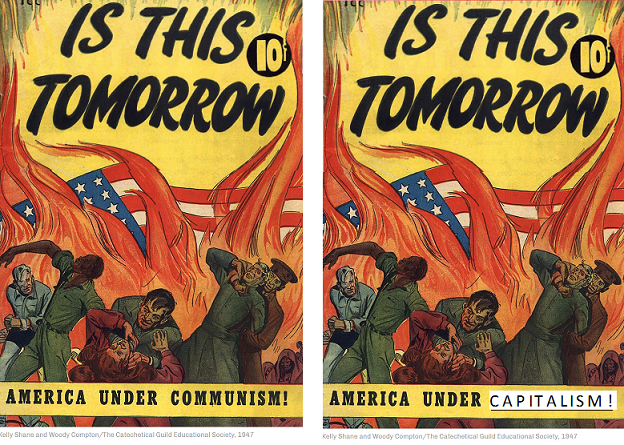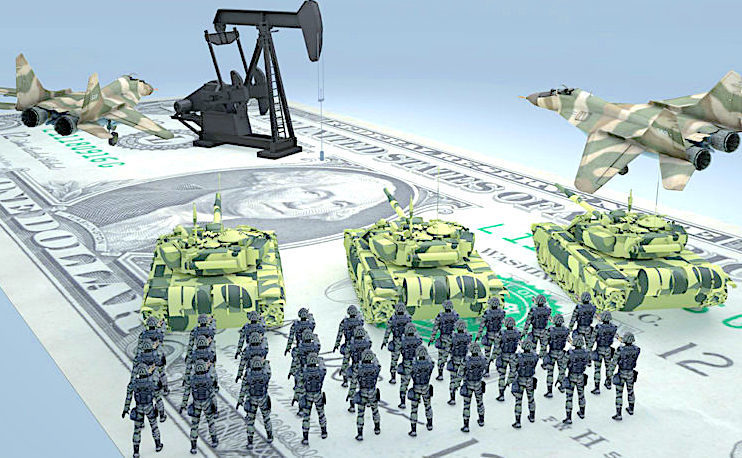
Christian Sorensen’s ambitious Understanding the War Industry documents the US war economy with zest. It’s a dull, monotonous topic but vitally important, and he manages to make it interesting.
You see the military-industrial-political complex as a vast, complex hive, embedded in the larger economic monster called the United States.
That union has always been tenuous, from the revolution to the civil war and today, requiring enemies to keep very different groups in line.
Ironically, since it kicked the British out, the US (i.e., the colonial settler regime) is the one country in the world that has never been threatened by external enemies, making enemy-production the driving force behind the military (always on guard).
The US is not at all like, say, Russia or Iran, countries that have experienced horrible invasions more than once.
Another irony here: compare Russian and Iranian military spending, indeed add up all the world’s military spending, and you will see that the enemyless US outspends them all added together.
How best to understand why a country with no enemies is constantly preparing for and fighting wars, wasting untold trillions, with only negative results (death, maiming, environmental degradation, pollution …).
Name me just one positive outcome from just the past two decades, the past half-century?
Sicko
Clearly the patient is sick. But is it the war industry to blame? And is the illness an addiction, like heroin? Yes, heroin is produced in record quantities and distributed with the help of the war machine.
But addictions can be controlled, and they only affect a small minority of the population. It’s possible to ‘just say no,’ though when a patient is sick with a real disease, heroin is at least some comfort.

Banksy’s gift to corona’s frontline troops
Sorensen compares the war industry to a cancer. Given the current viral pandemic, I think a virus is a better metaphor, and it is not the war industry per se that is the virus, but capitalism.
It is capitalism’s logic of expansion, conquest, exploitation that drives the war machine.
Cancer isn’t contagious, like capitalism with its profit and consumerism fetishes. There is no pandemic of cancer, like the coronavirus now spreading uncontrolled around the world.
The virus, very tiny and not even ‘alive’, replicating exponentially and mutating as needed, is the perfect analogue for capitalism, which is unseen, inhuman, and infects people without their knowing.
So don’t blame the war machine or think of it as a mysterious, spontaneous, malignant growth.
Capitalism is a kind of deus ex machina, highly contagious, infecting and debilitating and even killing the victim.
War and the war industry are merely the most horrible symptoms of the virus.
What is the nature of the virus? Where did it come from? How does it replicate?
These are the questions driving scientists and politicians with respect to corona, and inspired Marx and are driving Sorensen and me in analysis of our ills.
Marx diagnosed the industrial world of the 19th century. He identified the new disease as capitalism, exploitation of man by man, and prescribed a radical cure: revolt and the control of the means of production by the 99% of society who are the working people that make up society.
The cure was/is not easy, but the broad outlines included an end to war and exploitation.
How the virus works
Here are a few examples from Sorensen of how it replicates. Federal departments are encouraged to allocate 25% of procurement funds to small business.
How thoughtful. Isn’t that Adam Smith at work: help small business against the big monopolies, keep capitalism healthy?
The War Department (note: not ‘defense’ or ‘peace’) spends more for small business contracts than any other government department.
But these contracts by definition don’t need to be competitive. So the military is from the start padded at the cellular level.
But worse, ‘small’ is often not at all small. Corporations hold on to ‘small business’ classification long after they become large.
Furthermore, a large corporation can use a smaller subsidiary to enable contracting as a small business, even though the parent company is a behemoth.
Large corporations can sign up for the Pentagon’s Mentor Protege Program to help small businesses, giving the big fish the chance to partner or swallow (merge with) the little fish.
Let’s not even bother mentioning contracts with universities, and how that poisons the well of applied knowledge. A failing grade from Adam Smith.
Or the cooptation of native Americans, although theirs is somewhat of a success story.
The war machine is actually communism-in-action (for the military).

You join, get fed and clothed, excel, and get respect for being a brave soldier.
Natives have shone in the military ever since they were virtually wiped out and left destitute.
They (and blacks and hispanics) join up at twice the proportion of the population. They see a glimmer of communism and like it.
Their tribal traditions of valour and battle were harnessed to the beast.
Like small businesses, native companies get preferential treatment.
But just as the virus of capitalism turns sh*t into gold, it turns gold into sh*t too.
The tribes can sell services to the military, but often just farm them out to others, adding an extra layer of bureaucracy to earn a ‘profit’, like the notorious health maintenance organizations (HMOs) fleecing the country ‘for a good cause’.
Or like the bureaucracy in the Soviet Union, the bane of any attempt to replace capitalism.
Plagued by bureaucratic inertia, the final period in the Soviet Union from Brezhnev to Gorbachev, was called ‘real existing socialism’, which was derided as neither ‘real’ nor ‘existing’.
This is exactly where communism-for-the-War-Department is today in the US. There is no ‘war’, but there is no lack of bureaucracy.
Another irony: the War Department has never submitted annual audits (any audits) as all federal departments are supposed to.
Congress finally passed the Chief Financial Officers Act in 1990, just as the Soviet Union was bureaucracy run mad, teetering on the edge of collapse, not a threat to anyone but itself.
The coast was clear, but would this timid step be a signal that the beast’s days were numbered, that it would finally be brought to account?
Though the results were only of a small sampling of the monster’s activities, the grade was a failure, even though the auditors were all clients of the war machine and did their best to dot the i’s.
Auditors didn’t find any evidence of fraud in a system inherently fraudulent, wasteful and abusive. Pigs really do fly.
As with the end of WWII, the collapse of communism was supposed to lead to a peace dividend.
In both cases, within less than a year, war budgets of the beast were increasing. (For the Soviet Union in 1945, and for Russia in 1991, there was a peace dividend, as it was devastated in both cases, and had no help from the beast to rebuild its shattered economy.)
Sorensen served in the military and explains that ‘veteran’ is as loose a term as ‘small business’. Many (most?) ‘vets’ never leave the US, or just hang out in Europe, Korea or Japan for a few years.
‘Disabled’ is equally loose, as all vets-to-be are encouraged to bargain for some level of ‘disability’ to maximize their pensions and other perks upon retirement.
You can retire after 10 years and run a small business as ‘disabled, veteran-owned’.
The disease affects different people differently.
If you are really big and control lots of resources (US, Germany), you tend to become a bully, stealing from others or enslaving them to give you even more goodies.
If you get lazy, you can farm out the work to willing servant-slaves (China, Bangladesh, etc.).
What holds the lesser mortals in toe is of course a big fist. And the longer you dominate, the more you have to exercise that fist as a warning.
If someone defies you, your fist has to be ready to come down hard on him to stop others from getting any ideas.

Personal battle with virus
When I studied at Cambridge (1973–75), I was swept up in the excitement of Vietnam resistance to the US bully, rejoicing as we watched the last helicopter airlift the last US officials from the embassy in Saigon.
My friends were the handful of British communists studied there. My adviser told me about a professor friend at a sherry party asking, ‘How is Walberg doing? I hear he’s caught the bug.’
What he meant was I had joined in the Cambridge communist tradition, intellectuals enamored with the Soviet Union.
I was a bit offended, but dismissed that jibe and carried on. Eventually, of course, the Soviet Union collapsed, so by analogy, my worldview, the ‘bug’ I caught at Cambridge, should have died too.
Indeed, for much of the world, faith in the final victory of socialism/communism died in 1991, just as many lost faith during earlier bouts of illness the Soviet Union suffered (collectivization, repression).
But many of us remained alive and holding true to the faith.
There Is No Alternative.
I think I understand all this now. It is capitalism that holds the world in thrall, a virus that infects the entire world, and can only be fought by those immune to its blandishments.
The Soviet Union was building an alternative to capitalism, but that is hard work, kind of boring at times.
The virus, like corona, is well adapted to human instincts (aggression, sex, hunger, self protection).
Scientists have discovered there is genetic make-up in humans that promotes selflessness, altruism, love, spirituality, but these are secondary traits, luxuries that are only available to nurture when man doesn’t have to worry about survival.
I continue to marvel that despite the constant invasions and sabotage the Soviet Union faced, confronted by a powerful capitalist world, it survived at all.
That it saved the world from fascism alone should have earned it our eternal respect, but the sick patient was not interested in a cure.
It was able to survive over the centuries by embracing total war as a less demanding cure for any symptoms of dysfunction.
Fighting virus = just war = socialism
That is not to promote pacifism. WWII was a just war, fighting a real enemy that gloried in genocide and slavery for no purpose but further world conquest.
But that war was for socialism, and the West quickly adopted socialism for the duration of the war, since that was the way to motivate the people to make mortal sacrifices.
Capitalism, benefiting only a small elite, was not enough incentive.
Our governments were forced then by necessity to made a social contract with citizens, so that citizens (not ‘consumers’) would be willing to put their lives on the line, knowing their government would guarantee work, unemployment insurance, pensions and a post-war equitable social order.
Churchill and FDR signed the Atlantic Charter in August 1941 and the Declaration by United Nations on 1 January 1942, the basis for the modern United Nations.
That was what united us as one nation, and let us win WWII, rather than just churning out a lot of bombs. The war industry per se is neither good nor bad.
The (Liberal) Canadian government quickly set up Crown corporations, 28 of them by the end of the war, producing arms, tanks, whatever.
But in 1945 the implicit contract with the Soviet Union, that the world was now anti-imperialist, socialist, not fascist, was torn up, and private capital reasserted its dominance in politics and economics.
Late stage symptom
Thus, the virus took hold again in 1945, a ‘second wave’.
Like corona, capitalism mutates to meet any challenge.
Faced with Hitler, it mutated into state socialism.
Faced with a world in 1945 eager for real socialism, it mutated into the poisonous witchhunts of the 1950s.
It laid America low morally, and finally infected the Soviet Union and killed it.

1947 comic and 2020 reissue
Douglas Valentine’s TDY (2000), a battle between the CIA, DEA, Pentagon and a hapless GI caught in the middle, depicts how ‘a generation lost faith in the ideal that all Americans are united in a common cause.’
In hindsight though, it was not Vietnam, but WWII that was the last common cause.
But fighting is what makes America America.
The soldierly culture runs deep. I can’t seem to meet an American without some relative or friend in the armed forces.
And the wars, from the 19th century and the slaughter of the native peoples, till WWI and today, have been mercenary, immoral wars.
WWII is the one exception.
Where the US didn’t face the usual unending ‘insurgencies’, as the people welcomed the troops who delivered them from the Nazi scourge.
Another irony: though the US toots itself (and Israel) as a force for peace, if you look at the ‘real, existing’ peace it provides, it’s one of instability, violence and death, the peace of the dead.
We can only conclude that this is the intended result: chaos abroad requires the US war machine to pacify. This benefits the war machine, with some trickle-down to US workers and soldiers.
Real real peace would mean dismantling the machine.
Sorensen’s mass of evidence points to this as the ultimate goal. Just contemplate with him the hundreds of bases in the US alone, ’employing’ tens of millions, sucking up the nation’s food, dumping countless tons of CO2 and NO2 into the air, sea, land.
Doing what?
The US has NO enemies except the ones it makes. It could easily just stop bullying and dissolve the whole works, like Costa Rica.
Imagine all those $X,000,000,000,000 used to, say, pay people a basic income, make university education free, provide a bicycle for everyone, free public transit.

You get the picture.
But instead, millions of men (and, as a nod to feminists and lgbtqa) women, gays and transsexuals spend their time thinking and looking tough, devoted to the US war machine terrorizing the world.
But, as Sorensen points out, except for WWII, nothing has changed at all since the US invaded the Philippines in 1898 (‘clear, hold and build’), Vietnam ‘strategic hamlets’, Afghanistan ‘provincial reconstruction teams’.
A report by the Special Inspector General for Afghanistan Reconstruction concluded that ‘successes in stabilizing Afghan districts rarely lasted longer than the physical presence of coalition troops and civilians.’
By forcing American power onto helpless natives, the US replicates the insurgencies that have always plagued its imperial moves. And the natives today react much as the Filipinos did in 1898.
Bottom line: Destroy the village to save it.
The peace movement then was vocal, mainstream, and upfront anti-imperialist (Anti-Imperialist League), led by Mark Twain and many other prominent cultural figures. To no avail.
And when ‘our bastards’, like Batista in Cuba, Chavez in Venezuela, or Duterte in Philippines, tell the Yankees ‘out!’, it is like a cold chill, making the beast feel feverish, hatching ever new mutations, plans to thwart this latest challenge.
Strength through peace
There is no vaccine, we must fight to achieve that illusive ‘herd immunity’.
Once enough countries wake up and attack the virus resolutely, that should keep us safe, though socialism doesn’t mean stagnation.
To keep it healthy requires cultivating grassroots.
When the roots die, the virus can creep back into our lives.

Eric Walberg
Published by EricWalberg.com
The 21st Century
The views expressed in this article are solely those of the author and do not necessarily reflect the opinions of 21cir.
